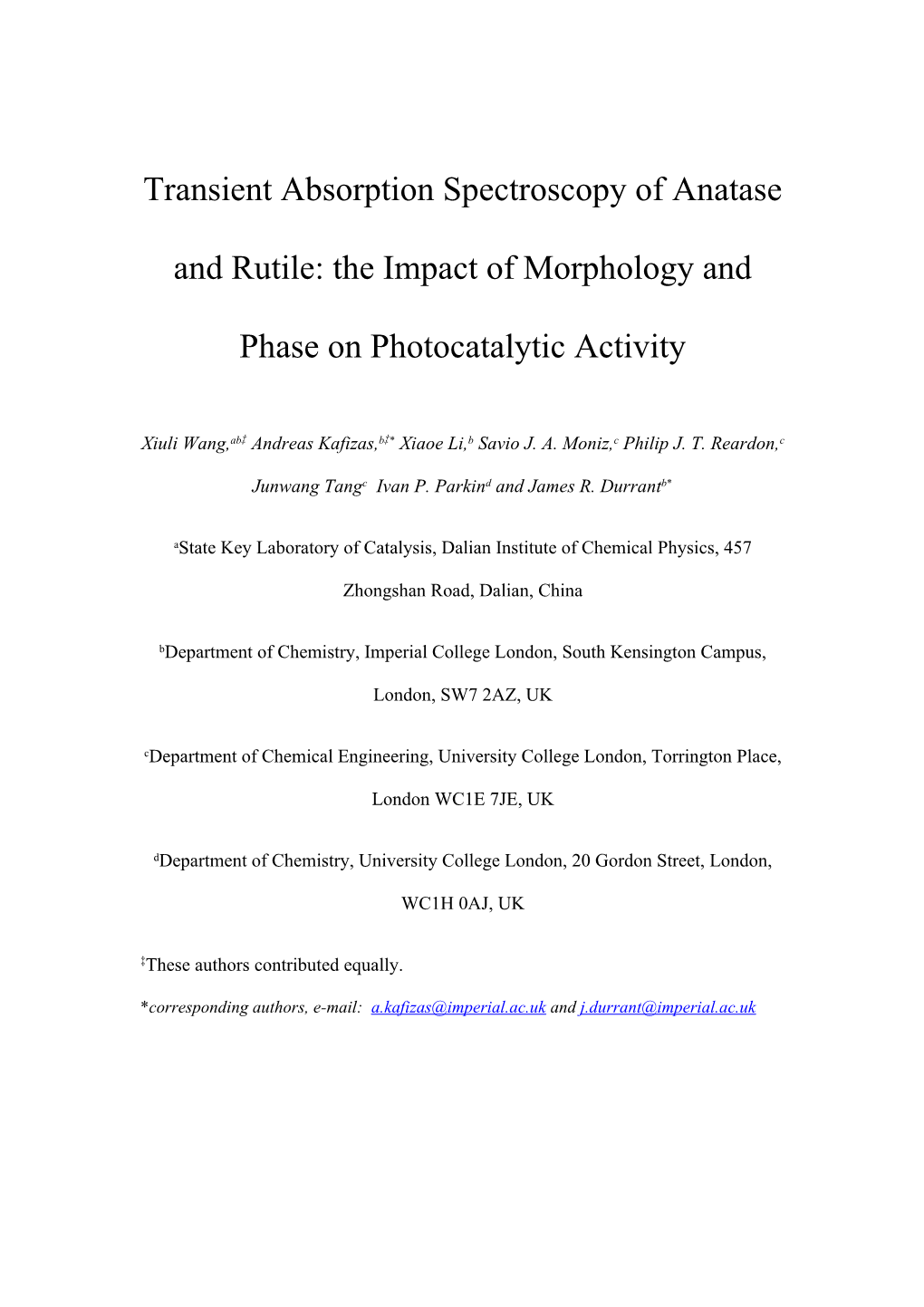Transient Absorption Spectroscopy of Anatase and Rutile: the Impact of Morphology and Phase on Photocatalytic Activity
Xiuli Wang,ab‡ Andreas Kafizas,b‡* Xiaoe Li,b Savio J. A. Moniz,c Philip J. T. Reardon,c Junwang Tangc Ivan P. Parkind and James R. Durrantb*
aState Key Laboratory of Catalysis, Dalian Institute of Chemical Physics, 457 Zhongshan Road, Dalian, China
bDepartment of Chemistry, Imperial College London, South Kensington Campus, London, SW7 2AZ, UK
cDepartment of Chemical Engineering, University College London, Torrington Place, London WC1E 7JE, UK
dDepartment of Chemistry, University College London, 20 Gordon Street, London, WC1H 0AJ, UK
‡These authors contributed equally.
*corresponding authors, e-mail: and
FigureS1: Emission spectra of the UVA 365 nm light source used for intelligent ink photocatalysis tests. Red and black dashed lines represent the bandgap energies of mesoporous anatase and rutile respectively.
FigureS2: X-ray diffraction patterns of (a) mesoporous anatase; a = 3.7848 (8) Å, c = 9.4937 (38) Å, wRp = 0.22, (b) mesoporous rutile; a = 4.5957 (8) Å, c = 2.9584 (10) Å, wRp = 0.21, (c) dense anatase; a = 3.7819 (3) Å, c = 9.4945 (40) Å, wRp = 0.14, d) dense rutile; a = 4.5888 (2) Å, c = 2.9539 (4) Å, wRp = 0.15) – each fit to a Le Bail refined model [dotted red lines].
The UV-visible transmittance and diffuse reflectance spectrum was measured for both mesoporous and dense samples using an integrating sphere and the true absorbance derived (Figure S3):
A (%) = 100 % - T (%) –R (%) (1)
where T(%) and R(%) are the transmittance and reflectance respectively. Both anatase and rutile are indirect bandgap semiconductors.1 A Tauc plot allows one to extract the indirect optical bandgap energy.2 The determined bandgaps were 3.17, 3.21, 2.98 and 2.93 eV for mesoporous anatase, dense anatase, mesoporous rutile and dense rutile respectively – similar to their literature values.3The true absorbance at the laser excitation wavelength used in our TAS studies (355 nm) was similar in both mesoporous anatase (81 %) and rutile (87 %). This was not fortuitous, where film thickness was adjusted so that similar levels of light absorbance were achieved (mesoporous anatase ~ 4.4 μm thick and mesoporous rutile films were ~ 1.0 μm thick).
FigureS3: UV-visible (a) transmittance and (b) reflectance spectra for mesoporous anatase [black line], mesoporous rutile [grey line], dense anatase [black dashed line], dense rutile [grey dashed line]and a blank glass substrate [black dotted line]. (c) True absorbance spectra derived from transmittance and reflectance data using Equation 1for dense anatase [black dashed line] and dense rutile [grey dashed line], where the inset shows extrapolated Tauc plots. (d) True absorbance spectra derived from transmittance and reflectance data using Equation 1for mesoporous anatase [black line], mesoporous rutile [grey line] and a blank glass substrate [dotted line]. The inset shows extrapolated Tauc plots for anatase and rutile.
FigureS4: BET N2 absorption [open diamonds]/ desorption [open circles] isotherm for (a) mesoporous anatase and (b) mesoporous rutile. Insets show BJH pore diameter distributions.
FigureS5:Transient absorption decays probed at 900 nm and recorded in an inert N2 atmosphere as a function of excitation intensity (355 nm laser, 6 ns pulse width, 1 Hz) for (a) mesoporous anatase and (b) mesoporous rutile.
FigureS6: Transient absorption decays probed at 900 nm and recorded in an inert N2 atmosphere of mesoporous anatase and rutile at low excitation intensity (355 nm laser, 6 ns pulse width, 1 Hz, ≈ 30 μJ.cm-2.pulse-1) either (a) not normalized or (b) normalized at 7 s.
FigureS7: Normalised transient absorption decays of dense (a) anatase and (b) rutile in both an inert N2 atmosphere or an N2 purged pure methanol solution probed at 460 and 900 nm following a 355 nm laser excitation pulse (6 ns pulse width, 1 Hz, 250 μJ.cm-2.pulse-1).
FigureS8: Transient absorption decays recorded in an inert N2 environment or an N2 purged pure methanol, isopropanol or glycerol solution for (a) mesoporousanatase probed at 900 nm [electron signal] and (b) mesoporous rutile probed at 550 nm [hole signal] after excitation by a 355 nm laser(6 ns pulse width, 1 Hz, 500 μJ.cm-2.pulse-1). Decays were normalised from 10 μs.
FigureS9: A transient absorption spectroscopy study of the various photocatalytic processes in intelligent ink. The transient decays were recorded in air, water, glycerol, resazurin dye (4 mM) and intelligent ink for (a) mesoporous anatase and (b) mesoporous rutile after back-excitation with a 355 nm laser (6 ns pulse width, 1 Hz, 250 μJ.cm-2.pulse-1) probed at 900 nm [electron signal].
FigureS10: Transient absorption decays probedat 550 nm[hole signal] and recorded in an inert N2 atmosphere or an N2 purged 2 mM AgNO3(aq)solution (excitationpulse 355 nm, 6 ns pulse width, 250 μJ.cm-2.pulse-1) for mesoporous anatase and rutile.
REFERENCES
(1) Sanjinés, R.; Tang, H.; Berger, H.; Gozzo, F.; Margaritondo, G.; Lévy, F. Electronic Structure of Anatase TiO2 Oxide. J. Appl. Phys.1994, 75, 2945.
(2) Tauc, J. Optical Properties and Electronic Structure of Amorphous Ge and Si. Mater. Res. Bull.1968, 3, 37.
(3) Scanlon, D. O.; Dunnill, C. W.; Buckeridge, J.; Shevlin, S. A.; Logsdail, A. J.; Woodley, S. M.; Catlow, C. . R. A.; Powell, M. J.; Palgrave, R. G.; Parkin, I. P.; Watson, G. W.; Keal, T. W.; Sherwood, P.; Walsh, A.; Sokol, A. A. Band Alignment of Rutile and Anatase TiO2. Nat. Mater.2013, 12, 798.
